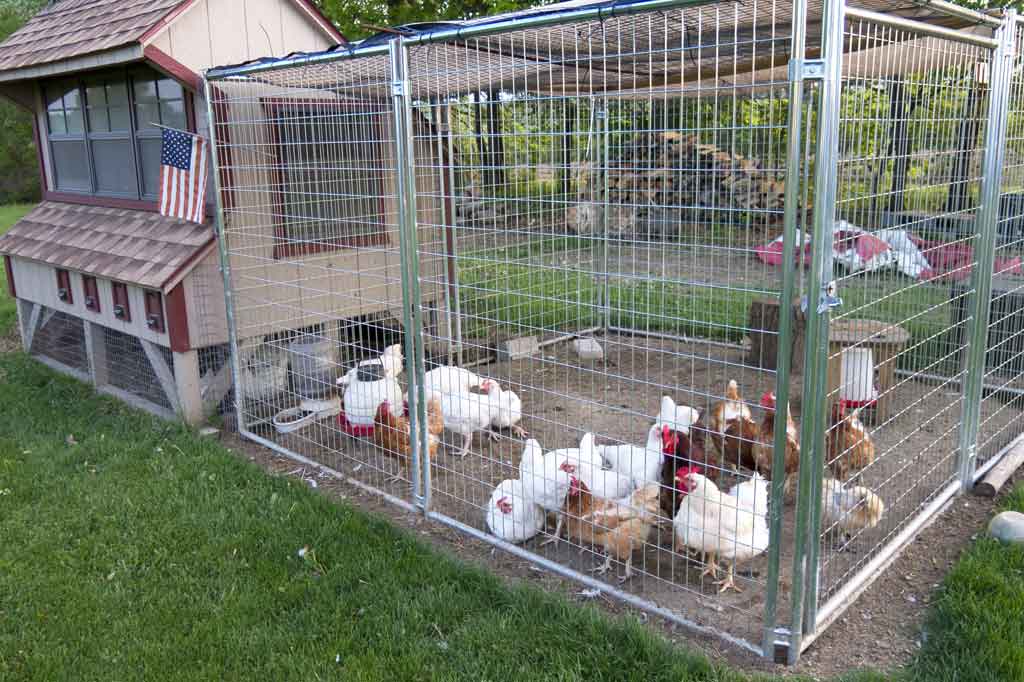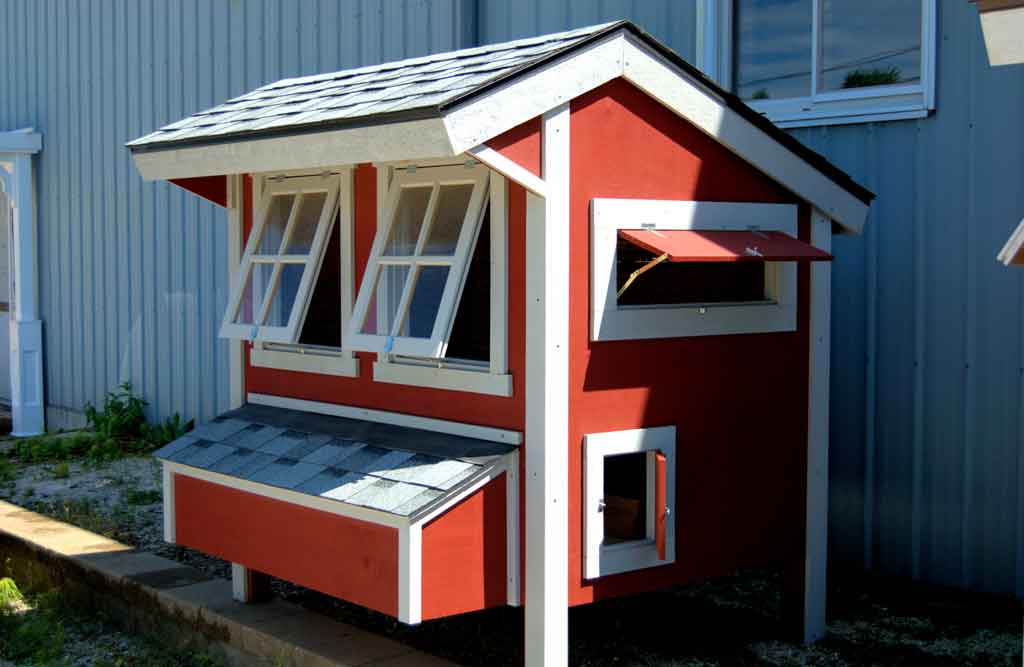Providing a way to ventilate a chicken coop is important and necessary for the health of the chickens. Proper chicken coop ventilation allows ammonia from chicken droppings to disperse. The keeps it from accumulating and becoming a toxic gas, causing stress or health problems in your chickens.
Chickens also continually give off moisture from their respiration and heat from their bodies. This can build up to unhealthy levels in the enclosed environment of a coop.
Unchecked moisture is also the cause of mold and mildew, both of which can cause respiratory problems.
Chicken coop ventilation is also integral to temperature control inside. In cold, wet temperatures, proper ventilation can keep the air healthy without admitting unnecessary cold or rain.
In hot weather, ventilation can help maintain a comfortable temperature inside the chicken coop. Ventilation is even more important:
- if your coop is placed in direct, hot sun
- when your coop is poorly insulated
- in the event your coop is made of a hot material like corrugated metal.
There are many ways to provide chicken coop ventilation, but it’s important that you do it correctly. Simply adding a window or opening in the coop may not be sufficient. Air flow must be adequate to keep the chickens healthy.
What kind of chicken coop ventilation is best?
There are two primary ways to ventilate a chicken coop:
- Making a window or opening and covering it with hardware mesh
- Purchasing a metal vent of the kind used in attics and installing it in the wall of your coop (this should also be covered securely with wire mesh)
Metal vents are more protection against rain but offer less air flow than a window. If you choose to use them as the primary way to ventilate a chicken coop, you will need to use a lot of them.
You need a minimum of 1 square foot of air ventilation per chicken inside the coop, and more if your coop is likely to get very hot in the summer.
If your coop is too small to allow the placement of enough vents or windows, you may need to add a mechanical air flow system, like a fan or a turbine, to ensure adequate air circulation and fresh air.
Wind turbine
You can add a wind turbine to the roof of your coop. When the wind blows, it pushes the blades of the turbine, drawing inside air up and out of the coop. These are effective ventilation systems but can’t be the primary source of air flow because they don’t circulate enough air in general, and because they only operate when blown by the wind. On still days, they don’t benefit the needs of the chickens
Mechanical fan
We us mechanical fans to add more air flow in our coop since it has fewer and smaller windows. You can use a mechanical fan best as an exhaust fan, in the wall and blowing air out, rather than directed to blow air in. We installed two small, outdoor-rated fans near the top of the coop.
Be mindful that a household fan is not durable enough to withstand the dusty conditions inside a chicken coop; you will need one designed for use in a barn or workshop, which will be more expensive.
You shouldn’t rely on a mechanical air flow system as the sole method of providing chicken coop ventilation. The exception would be if it is designed specifically for the air flow in your coop. These are typically a more expensive solution.
If at all possible, add windows or vents at a minimum of 1 square foot of opening per bird. Mechanical systems should augment this natural, passive air flow during hot months, or as needed.
Placement of vents
Placement of vents is key to the design. Simply placing a lot of windows doesn’t necessarily ensure the flow of air through the coop, carrying heat, moisture, and harmful gasses outside and away from the chickens.
Some key facts to keep in mind:
- Warm air rises, while cool air descends
- Chickens sleep above the floor, on a roost
- They are usually more tolerant of cold temperatures, because their feathers insulate them
- Chickens are less tolerant of hot temperatures, because they can’t decrease their body heat by sweating
So, to ensure good air flow:
- Place ventilation on opposite walls, if not all the walls, so that air can move through the space
- Place vents higher on the wall than, but not directly above, the roost, so that warm air can escape, but the chickens aren’t sleeping in a cold draft
- In hot climates, add another ventilation point (or several) down lower on the wall, so that cool air can enter below, and warm air can exit out of the higher vents.
More chicken coop ventilation tips
Ventilation is a year-round necessity, even in cold weather. If your coop is well ventilated, chickens can typically withstand cold temperatures. The key is to make sure the air inside isn’t accumulating excess moisture. If the air inside the chicken coop is damp from droppings and the bird’s exhalations, they are more susceptible to frostbite.
To add ventilation without causing drafts or letting rain inside, many people:
- place their primary ventilation outlets very high on the wall
- just beneath the roofline
- on two or more walls of the coop
- running the length of the wall.
In hot climates, adding another source of air flow down lower helps to keep the coop cool. But, be attentive to the resulting air flow. You want to avoid currents of cold air horizontally along the floor where chickens walk. Also try to avoid air currents vertically just past the roost where they sleep.
Use galvanized hardware cloth to cover all openings in the coop. Remember that you don’t want pests to squeeze through the openings, or predators to reach through the openings to grab a chicken.
If you make it secure enough that a predator could push or pull on it without dislodging, it should be strong enough to keep your chickens safe. We like to check the security of our mesh a few times a year to make sure it is still firmly attached.
Bonus chicken coop ventilation advice
Pinterest has lots of photos showing ventilation ideas
Pinterest chicken coop ventilation photo ideas (opens in a new browser tab)
Conclusion
Chicken coop ventilation is crucial to the well-being and good health of your chickens, and more is always better. Consider not just the size of vents, but also their placement to ensure good, consistent air flow in your coop.
Do you love to spoil your chickens with great healthy food? These are the same mealworms that we feed to our hens every day. They absolutely love them!

We’ve been ordering them on Amazon from the same seller for about a year now and they provide consistent quality. Try a bag today!

